What Do Sea Turtles Eat?
May 21, 2020May 9, 2019 by C.B. Daniels
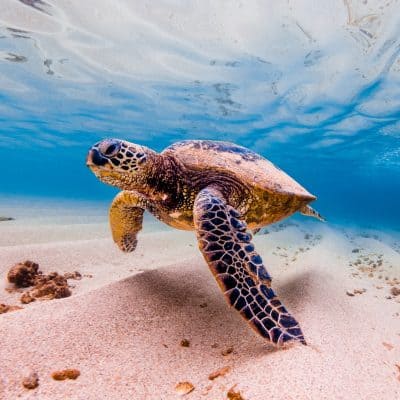

The Short Answer: It depends upon the species. While most adult sea turtles are omnivores (they eat both animals and plants), some species are either carnivores (meat eaters), herbivores (plant eaters), or have a specialized diet.
For detailed information about sea turtles and what each species eats, read on.
Contents
1.1 What Do Baby Sea Turtles (Hatchlings) Eat?
1.2 What Do Adult Sea Turtles Eat?
1.2.4 Kemp’s Ridley Sea Turtles
1.2.7 Olive Ridley Sea Turtles
3 Other articles you might enjoy
What Are Sea Turtles?
Sea turtles are reptiles (like snakes and lizards) which means that they are cold-blooded vertebrates (they have backbones) that have scales. They are in the class Reptilia and in the order Testudines.
There are seven species of sea turtles: flatback sea turtles, green sea turtles, hawksbill sea turtles, Kemp’s ridley sea turtles, leatherback sea turtles, loggerhead sea turtles, and olive ridley sea turtles.
Unfortunately, six of the seven species are listed as threatened or endangered (flatback sea turtles are the exception).
Sea turtles have been around for millions of years (since the time of dinosaurs) and are found in almost every ocean (but not the Arctic and the Antarctic oceans). Depending on the species, they can live upwards of 50 years and are sexually active for about 30 of those years.
Fun Fact: Unlike land turtles, sea turtles can’t retract their head and legs inside their shells.
What Do Baby Sea Turtles (Hatchlings) Eat?
Baby sea turtles are called hatchlings and often have a different diet than adult sea turtles do.
Because they are reptiles, sea turtles hatch from soft-shelled eggs. The reproduction period and nesting locations differ by species, but all species of sea turtle lay their eggs in the sand.
After an incubation period, the baby sea turtles will then break out of their eggs with a temporary egg tooth known as a caruncle. They then dig themselves out of their nest (this process can take days) and make their way to the ocean (often at night time to reduce the chances of being eaten by a predator).
Sadly, even though most female sea turtles can lay around 80-120 eggs per clutch, it is estimated that only 1 in 1,000 hatchlings survive to adulthood. The world is a dangerous place for a baby sea turtle!
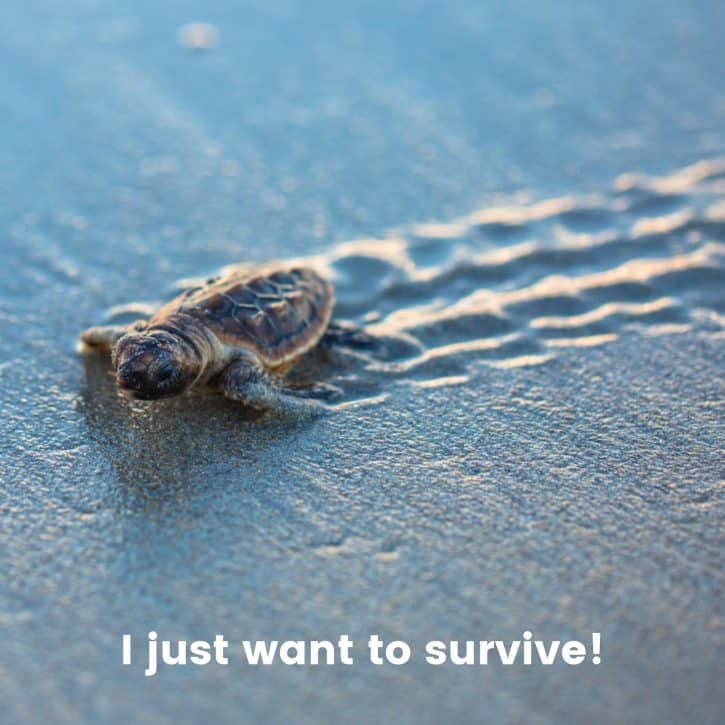
Once in the ocean, hatchlings start what is called a “swimming frenzy” where they swim continuously for long periods of times (sometimes days). This helps the hatchlings get to deeper waters where they can better avoid predators.
When baby sea turtles first hatch, they live off the yolk from their eggs for the first couple of days, until they can make it to the ocean.
Sea turtle hatchlings are omnivores, but their diet may change when they become adults.
Also, even though hatchlings are technically omnivores, they start off mostly carnivorous and progress into eating plants as they mature. Most of their plant eating is toward the juvenile stage of their life.
Some of the foods that hatchlings eat are algae, crustaceans, fish eggs, jellyfish, hydrozoans, mollusks, seagrasses, and seaweed.
Fun Fact: Sea turtle gender is influenced by temperature. Warmer temperatures produce females, and colder temperatures produce males.
What Do Adult Sea Turtles Eat?
As mentioned previously, it depends upon the species.
Sea turtles have a variety of diets that range from herbivore (plant-eating) to carnivore (meat-eating) to omnivore (eating both plants and animals) to specialized diets (where they eat a highly specific diet).
Not only do sea turtles’ diets depend upon their species, but they also depend upon their age. A sea turtle may start off as an omnivore as a baby but become an herbivore as an adult.
Because sea turtles have such diverse diets, the easiest way to determine their food preference is to look at the shape of their jaws. We’ll look at how each type of sea turtle jaw is specialized for their diet.
Flatback Sea Turtles
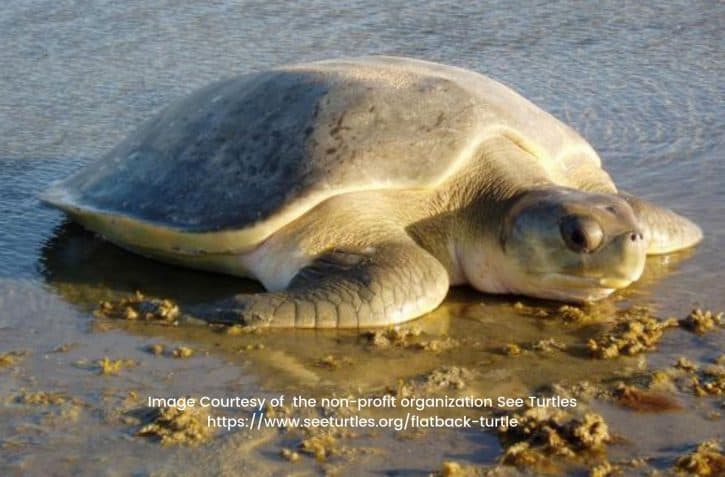
Adult flatback sea turtles (Natator depressus) are technically omnivores, but they predominately eat meat.
Flatbacks have slightly serrated lower jaws that are adapted for eating mostly marine invertebrates that don’t have backbones. However, they do infrequently eat some plants such as seagrasses or seaweed.
Some foods that flatback sea turtles eat are cuttlefish, fish, jellyfish, mollusks, sea cucumbers, shrimp, and soft corals.
Fun Fact: Flatback sea turtles are the only one of the seven species that are not found in U.S. waters. They are only found in waters around Australia and Papua New Guinea.
Green Sea Turtles

Adult green sea turtles (Chelonia mydas) are herbivores.
Greens have a saw-like beak that has serrated edges that are well-suited for scraping off algae and for eating vegetation.
Funnily enough, green sea turtles are not green colored. Instead, they are often a combination of black, brown, gray, and yellow. Their name comes from the fact that their internal fat tissue is green due to their herbivore diet.
Some foods that green sea turtles eat are algae, seagrasses, and seaweed.
Fun Fact: The seagrass Thalassia testudinum is known as “turtle grass” because in certain areas green sea turtles graze almost exclusively on this grass.
Hawksbill Sea Turtles
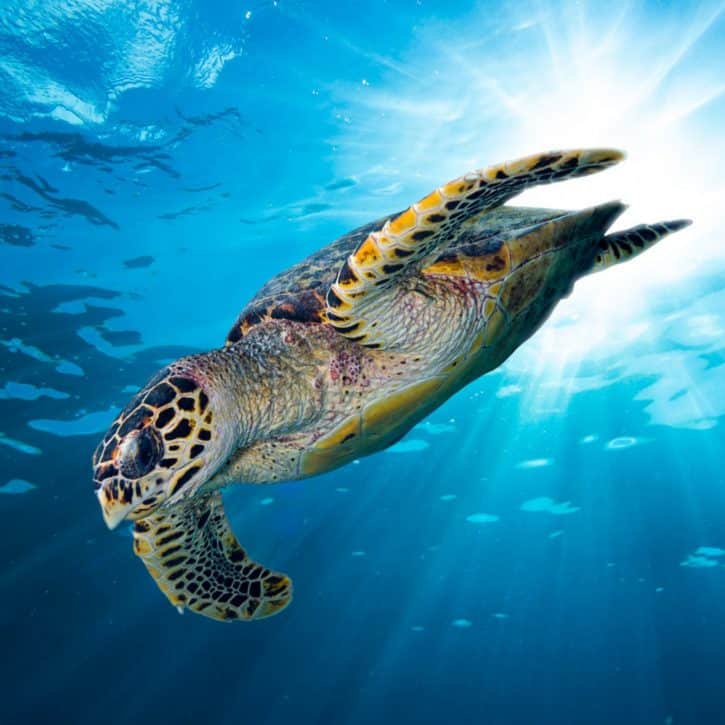
Adult hawksbill sea turtles (Eretmochelys imbricate) are omnivores but are also called spongivores because they have a specialized diet that consists mainly of sponges.
Hawksbills have narrow, sharp beaks that are, wait for it, hawk-like. These beaks have angled jaws which are adapted to help them reach into crevices easily to eat sponges.
Sponges have spicules which are hard, glass-like structural elements that are meant to deter predators. They also contain toxins for self-defense as well. However, hawksbills have adapted to be able to ingest sponges anyway. While this is great for hawksbill sea turtles, this means that hawksbills are toxic to humans if eaten.
Some other foods that hawksbill sea turtles occasionally (but rarely) eat are algae, sea anemones, seagrasses, shrimp, squids, and tunicates.
Fun Fact: Hawksbill sea turtles are the only known spongivorous reptile, and they can eat up to 1,200 lbs. of sponges a year.
Kemp’s Ridley Sea Turtles

Adult Kemp’s ridley sea turtles (Lepidochelys kempii) are carnivores.
Kemp’s ridleys have strong, powerful jaws that are well-suited to crushing and grinding their prey. Even though they can eat a wide variety of prey, they greatly prefer to eat crabs.
Some other foods that Kemp’s ridley sea turtles eat are fish, jellyfish, mollusks, and shrimp.
Fun Fact: Kemp’s ridley sea turtles are the smallest sea turtles, and they rarely weigh over 100 lbs.
Leatherback Sea Turtles
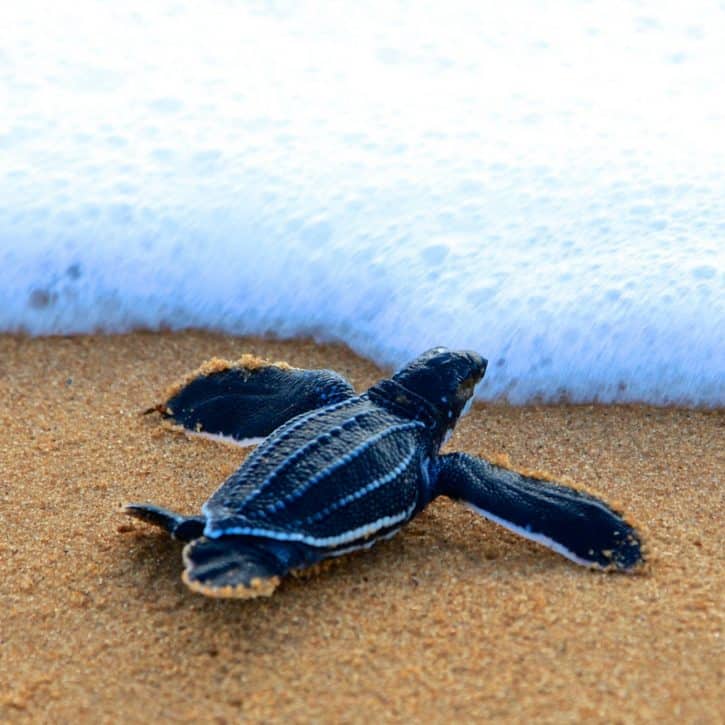
Adult leatherback sea turtles (Dermochelys coriacea) are carnivores but are also called gelatinavores because they have a specialized diet of gelatinous animals (mainly jellyfish).
Leatherbacks have delicate, scissor-like jaws that are well-suited for eating soft, gelatinous prey. They also have two pointed cusps on their jaws (one on their upper and one on their lower) that helps them pierce their prey to capture it.
Leatherbacks also have papillae in their mouth and throat which are downward curving spines that help them to maneuver their prey into their stomach.
Because they are often attracted to clear, floating masses (like jellyfish), leatherbacks often accidentally consume plastic bags. This has led to many deaths due to intestinal blockage or malabsorption.
Some other foods that leatherback sea turtles eat are sea squirts and tunicates.
Fun Fact: Leatherback sea turtles are the largest of the sea turtle species and can weigh over 1,500 lbs. They can also eat twice their body weight in prey daily!
Loggerhead Sea Turtles

Adult loggerhead sea turtles (Caretta caretta) are carnivores.
Loggerheads have strong, large jaws that are adapted for crushing hard-shelled prey. They have the widest variety of prey out of all the sea turtles.
Some foods that leatherback sea turtles eat are barnacles, conchs, corals, crabs, jellyfish, mollusks, sand dollars, sea anemones, sea cucumbers, sea urchins, shrimp, sponges, squids, starfish, and whelks. They will also eat sea turtle hatchlings (even their own species). They are hardcore eaters!
Olive Ridley Sea Turtles

Adult olive ridley sea turtles (Lepidochelys olivacea) are technically omnivores, but they mainly eat meat.
Olive ridleys have powerful jaws that are well-suited for eating a variety of foods. While they often eat meat, they will eat algae if food is scarce.
Some foods that olive ridley sea turtles eat are crabs, fish, jellyfish, lobsters, sea urchins, shrimp, and tunicates.
Fun Fact: Olive ridley sea turtles are named for their olive-green colored shell and are the most abundant sea turtles in the world.
Summary
Depending on the species and age, sea turtles can be omnivores (eat both animals and plants), carnivores (meat eaters), herbivores (plant eaters), or have a specialized diet.
Sea turtles are reptiles which are cold-blooded vertebrates that have scales. They are in the class Reptilia and in the order Testudines.
There are seven species of sea turtles: flatback sea turtles, green sea turtles, hawksbill sea turtles, Kemp’s ridley sea turtles, leatherback sea turtles, loggerhead sea turtles, and olive ridley sea turtles.
Baby sea turtles (hatchlings) are omnivores, but they start off predominately eating meat, and can progress into different diets as they get older.
Adult flatback sea turtles are technically omnivores, but they predominately eat meat. Flatbacks have slightly serrated lower jaws that are adapted for eating mostly marine invertebrates that don’t have backbones.
Adult green sea turtles are herbivores. Greens have a saw-like beak that has serrated edges that are well-suited for scraping off algae and for eating vegetation.
Adult hawksbill sea turtles are omnivores but are also called spongivores because they have a specialized diet that consists mainly of sponges. Hawksbills have narrow, sharp beaks that have angled jaws which are adapted to help them reach into crevices easily to eat sponges.
Adult Kemp’s ridley sea turtles are carnivores. Kemp’s ridleys have strong, powerful jaws that are well-suited to crushing and grinding their prey.
Adult leatherback sea turtles are carnivores but are also called gelatinavores because they have a specialized diet of gelatinous animals (mainly jellyfish). Leatherbacks have delicate, scissor-like jaws that are well-suited for eating soft, gelatinous prey.
Adult loggerhead sea turtles are carnivores. Loggerheads have strong, large jaws that are adapted for crushing hard-shelled prey.
Adult olive ridley sea turtles are omnivores, but they predominantly eat meat. Olive ridleys have powerful jaws that are well-suited for eating a variety of foods.
Other articles you might enjoy
Hi my name is C.B. Daniels and I make websites. I’ve also always been fascinated by animals. I thought that some of the information about animal diets and pet names was a little thin. So I figured I’d make this site to remedy that! I hope to make this site a hub for information about what animals eat, fun names you can use for your pets, and general animal information. Hopefully, you’ll find all the information about animals you are looking for and much more!
Latest posts by C.B. Daniels (see all)
- Can Rabbits Eat Grapes? - November 12, 2022
- Can Rabbits Eat Cucumbers? - November 3, 2022
- Can Rabbits Eat Spinach? - November 3, 2022